|
This
picture gallery summarizes the biota found under boulders at Playa Estacion,
Puerto Penasco, Sonora, Mexico.
It should
be used to complete lab activity 9.4.
|
Isognomon
janus
|
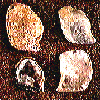 |
"Purse
shell"
| Phylum |
Mollusca |
| Class |
Pelecypoda |
| Order |
Pterioida |
| Family |
Isognomonidae |
|
| Morphology |
Very
thin, elongate, pale tan shell with 7-9 pits along hinge margin |
| Feeding |
Filter feeder |
| Defense |
Shell and ability
to live in tight spaces |
| Reproduction |
Separate sexes
and spawning |
| Habitat |
Under rocks
and in crevices in sandy or muddy areas of the intertidal and
shallow subtidal |
| Distribution |
Lower Pacific
Baja, throughout the Gulf of California, south along Mexico's
Pacific coast |
| Other |
|
|
|
Barbatia
reeveana
|
 |
"Reeve's
ark shell"
| Phylum |
Mollusca |
| Class |
Pelecypoda |
| Order |
Arcoida |
| Family |
Arcidae |
|
| Morphology |
Large,
white, ribbed shell with dark brown, fuzzy periostracum. Shape
often distorted from growing between rocks. |
| Feeding |
Filter feeder |
| Defense |
Shell and ability
to live in tight spaces |
| Reproduction |
Separate sexes
and spawning |
| Habitat |
Under rocks
in sandy or muddy areas of tidal flats and subtidally in lagoons |
| Distribution |
Lower Pacific
Baja, throughout the Gulf of California, south to Peru |
| Other |
|
|
|
Stenoplax
conspicua
|
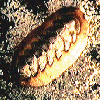 |
"Conspicuous
chiton"
| Phylum |
Mollusca |
| Class |
Polyplacophora |
| Order |
Chitonida |
| Family |
Ischnochitonidae |
|
| Morphology |
Elongate;
pink brown or green brown shell; fleshy girdle surrounding the
shell plates with short spines; over 2 inches long. |
| Feeding |
Scrapes algae
from rocks. |
| Defense |
Strongly clings
to rocks and is protected by eight, overlapping shelly plates |
| Reproduction |
Spawning |
| Habitat |
Under intertidal
rocks. |
| Distribution |
Northern and
central Gulf of California. |
| Other |
|
|
|
Chiton
virgulatus
|
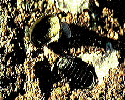 |
"Striped
chiton"
| Phylum |
Mollusca |
| Class |
Polyplacophora |
| Order |
Chitonida |
| Family |
Chitonidae |
|
| Morphology |
Elongate;
dark olive brown shell; fleshy girdle surrounding the shell
plates with alternating dark and light bands; about 1.25 to
2.5 inches long. |
| Feeding |
Scrapes algae
from rocks. |
| Defense |
Strongly clings
to rocks and is protected by eight, overlapping shelly plates |
| Reproduction |
Spawning |
| Habitat |
Under intertidal
rocks. |
| Distribution |
Lower west coast
of Baja California to the northern region of the Gulf of California. |
| Other |
Most common
chiton in the Gulf of California |
|
|
Nerita
funiculata
|
 |
"Small
nerite"
| Phylum |
Mollusca |
| Class |
Gastropoda |
| Order |
Archeogastropoda |
| Family |
Neritidae |
|
| Morphology |
Globular
shell, black to gray, with spiral ribs. Inner lip of aperture
with small nodules. Tight fitting operculum forms water tight
seal. Commonly 0.75 inches in diameter. |
| Feeding |
Scrapes algae
from rocks. |
| Defense |
Active on tops
of rocks at low tide |
| Reproduction |
|
| Habitat |
On rocks at
high tide levels. |
| Distribution |
Outer coast
of Baja California, through the Gulf to Peru. |
| Other |
Gregarious found
in clumps of up to several hundred individuals. |
|
|
Nerita
scabricosta
|
 |
"Rough-ribbed
nerite"
| Phylum |
Mollusca |
| Class |
Gastropoda |
| Order |
Archaeogastropoda |
| Family |
Neritidae |
|
| Morphology |
Globular
shell, black to gray, with spiral ribs. Inner lip of aperture
with 4 large teeth. Tight fitting operculum forms water tight
seal. Commonly 1.5 inches in diameter |
| Feeding |
Scrapes algae
from rocks. |
| Defense |
Live high in
the intertidal |
| Reproduction |
|
| Habitat |
On rocks at
high tide levels. |
| Distribution |
Outer coast
of Baja California, through the Gulf to Equador. |
| Other |
Snail increases
in size as one moves south in the Gulf. |
|
|
Turbo
fluctuosus
|
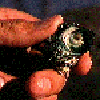 |
"Turban
shell"
| Phylum |
Mollusca |
| Class |
Gastropoda |
| Order |
Archeogastropoda |
| Family |
Turbinidae |
|
| Morphology |
Top-shaped
shell with a heavy calcarous operculum. Color is variable, from
bright orange to dark green. Commonly 2.5 inches. |
| Feeding |
Grazes on algae. |
| Defense |
Closes its shell
aperature with a hard, calcareous operculum |
| Reproduction |
|
| Habitat |
Abundant on
rocky shores. |
| Distribution |
Throughout the
Gulf of California and south to Peru and Ecuador |
| Other |
Operculum is
collected for jewelry. Best observed at night. |
|
|
Columbella
fuscata
|
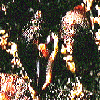 |
"Dove
shell"
| Phylum |
Mollusca |
| Class |
Gastropoda |
| Order |
Neogastropoda |
| Family |
Columbellidae |
|
| Morphology |
Red
brown shell with green to brown periostracum and purple white
aperture. |
| Feeding |
Tear off bits
of seaweed |
| Defense |
Shell with narrow
aperture |
| Reproduction |
Seperate sexes,
attach egg capsules to seaweeds |
| Habitat |
Under intertidal
rocks and in tidepools |
| Distribution |
Lower Pacific
Baja, throughout the Gulf of California, south to Peru |
| Other |
|
|
|
Diadora
inaequalis
|
 |
"Orange
keyhole limpet"
| Phylum |
Mollusca |
| Class |
Gastropoda |
| Order |
Archaeogastropoda |
| Family |
Fissurellidae |
|
| Morphology |
Opening
at top of cap-shaped shell; fleshy orange mantle; broad in middle
and constricted at both ends. |
| Feeding |
Graze on microscopic
algae on rocks. |
| Defense |
Clamp tightly
to rocks and are protected by shell |
| Reproduction |
|
| Habitat |
Found on the
underside of rocks in the intertidal. |
| Distribution |
Throughout the
Gulf of California, south to Galapagos Islands. |
| Other |
|
|
|
Octopus
fitchi
|
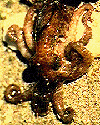 |
"Fitch's
octopus"
| Phylum |
Mollusca |
| Class |
Cephalopoda |
| Order |
Octopoda |
| Family |
Octopodidae |
|
| Morphology |
Small,
reddish brown octopus with an elongate body 0.5 to 1.25 inches
long with 8 arms 2.5 to 3 times the length of the body. |
| Feeding |
Carnivorous
on invertebrates especially crabs and other crustacea |
| Defense |
Can change color
to match its background and can hide in cramped spaces. Can
swim by jet propulsion and can bite. |
| Reproduction |
Male transfers
sperm to female using a specialized arm. Female deposits eggs
singly on undersides of rocks. Planktonic larvae. |
| Habitat |
Under rocks
in the subtdial and intertidal |
| Distribution |
Northern Gulf
of California |
| Other |
Has a reputation
for biting and some people may be allergic to its salivary venom. |
|
|









